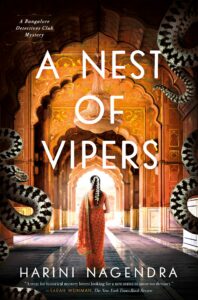Bangalore Detectives Club #3
 I am a huge fan of this fledgling series set in 1920’s Bangalore. The books are set around the same time at Sujata Massey’s Perveen Mistry books, but in a different part of India. However, all the parts of India were experiencing the same thing: a desire for independence from their British overlords. Massey has a book about the Prince of Wales’ visit to then colonial India, The Bombay Prince, and this is Negendra’s book about that same visit. Gandhi was calling for peaceful protests (much like Martin Luther King) and throughout India there were welcomes for the Prince with an undercurrent of revolution. India did not actually gain independence until 1947, so this is a story of a nascent movement, brought out of the shadows by the visit of a British royal.
I am a huge fan of this fledgling series set in 1920’s Bangalore. The books are set around the same time at Sujata Massey’s Perveen Mistry books, but in a different part of India. However, all the parts of India were experiencing the same thing: a desire for independence from their British overlords. Massey has a book about the Prince of Wales’ visit to then colonial India, The Bombay Prince, and this is Negendra’s book about that same visit. Gandhi was calling for peaceful protests (much like Martin Luther King) and throughout India there were welcomes for the Prince with an undercurrent of revolution. India did not actually gain independence until 1947, so this is a story of a nascent movement, brought out of the shadows by the visit of a British royal.
Negendra opens her novel with a luscious visit to a circus – she’s excellent at setting and at populating a scene and bringing it fully to life. It’s one of the things I love most about these books. Our heroine, Kaveri Murthy, and her handsome doctor husband, Ramu, have received free tickets and are sitting toward the front of the house next to a British doctor and his sister and they’ve brought along their friend Anandi (met in previous books). The headliner is a magician who actually asks to meet the Murthys before the performance – he’s heard of Kaveri’s “detective club” and seems interested in her help.
The magician is the main attraction, and when he and his son take the stage, chaos ensues halfway through the performance, with a gang of masked men surging through the crowd, robbing the rich people in the front rows. The magician disappears, leaving his son behind, and the brutal ex husband of their beloved Anandi is discovered dead in the resulting confusion, with Anandi the apparent murderer. Kaveri’s task through this book is twofold: reuniting the magician’s son with his father and proving Anandi’s innocence.
Troublingly, Anandi has turned cold toward Kaveri and then vanishes; and Kaveri’s former police ally, Inspector Ismail, has turned similarly cold toward her. In the past, he had welcomed her help; now, he will hardly speak to her. In the last book Kaveri and her mother in-law made peace with one another; in this book, her mother in law is frequently absent, forcing Kaveri to consider how she might spend her time if not with her studies or with her mother in law. Her detective club meetings – populated by women she’s met through her work – are her saving grace.
In each novel, Kaveri grows a little bit as a person, and the strong binding thread is the love she and Ramu have for one another. While he worries about her, he still allows her the freedom to make her own choices about how she’ll proceed. So while she’s handicapped by the loss of Ismail’s support and Anandi’s friendship, she still moves forward, helping the magician’s young son and attempting to discover the true killer of Anandi’s husband.
The Bangalore setting is textured and the other thread of this novel – the thread of the growing independence movement – is subtly tied into the plot in an extremely nuanced manner. Nagendra manages to capture a spectrum of complicated feelings on the part of the people she’s portraying in the novel. There’s a thought that a riot or violence accompanying the prince’s visit will make things worse for the movement and set it back, so the other tension involves whether violence will indeed break out before the end of the book.
Like Elizabeth Peters and Dorothy Gilman before her, Nagendra is truly a writer not just of detective stories but of adventure stories, stories that also embrace and celebrate a culture. Unlike Peters and Gilman she is writing about her own culture, which makes it a very resonant reading experience. However, I’m certain that Amelia Peabody, Mrs. Pollifax and young Kaveri Murthy would happily enjoy one another’s company. This is an utterly delightful series. — Robin Agnew